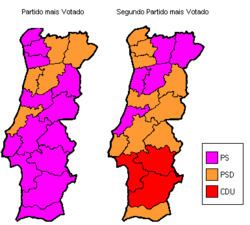27 September 2009 2011 → 29 September 2004 31 May 2008 121 seats, 45.0% 75 seats, 28.8% | Registered 9,519,921 6.4% 31 May 2008 21 April 2007 Start date September 27, 2009 | |
 | ||
Turnout 5,681,258 (59.7%)
4.6 pp Winner José Sócrates | ||
Legislative elections in Portugal were held on 27 September 2009 to renew all 230 members of the Assembly of the Republic. The Socialist Party, led by incumbent Prime Minister José Sócrates, won the largest number of seats, but didn't repeat the overall majority they gained in 2005.
Contents
The Socialist Party of Prime Minister José Sócrates came in first despite losing 9% of the vote and 24 seats.
In these elections there were approximately 9.5 million Portuguese at home and abroad called to determine the 230 seats in the Assembleia da República and 18th constitutional government in Portugal after 1976. The Socialists won the election with a clear lead over the conservative Social Democrats, with big gains for the People's Party and for the Left Bloc.
The election took place during the regular end of the previous four-year legislative period. From 2005 to 2009 ruled by the Socialist Party (PS), led by José Sócrates, with an absolute majority. The opinion polls at the beginning of the official election campaign on 12 September 2009, showed a too close to call race between the Socialists and the conservative Social Democrats, but just days before the election the Socialists increased their lead over the Social Democrats. A total of 13 parties and two coalitions competed in this election.
Focus of the campaign were the impact of global economic and financial crisis and the construction of new infrastructure projects, including the high-speed rail link Lisbon-Madrid and Lisbon-Porto-Vigo and the new Lisbon airport.
Neither of the two major parties won an absolute majority in the Assembly of the Republic, so, the future prime minister must form a coalition, or at least rely on other parties to govern. In this case, José Sócrates is in a better position than Manuela Ferreira Leite, since the Portuguese left won by 54.23% of the vote and 128 seats, against 39.54% and 102 deputies to the right.
On 12 October, José Sócrates was invited by President Aníbal Cavaco Silva to form government. The new cabinet was announced on 22 October and sworn in on 26 October.
Voter turnout was one of the lowest in Portuguese election history, as 59.7% of the electorate cast a ballot.
Electoral system
The Parliament of the Portuguese Republic consists of a single chamber, the Assembly of the Republic, composed of 230 members directly elected by universal adult suffrage for a maximum term of four years. Assembly members represent the entire country, rather than the constituencies in which they were elected. Governments require majority support in the Assembly in order to remain in office.
Each one of Portugal's eighteen administrative districts, as well as each one of the country's two autonomous regions - the Azores and Madeira - is an electoral constituency. Portuguese voters residing outside the national territory are grouped into two electoral constituencies - Europe and the rest of the world - each one of which elects two Assembly members. The remaining 226 seats are allocated among the national territory constituencies in proportion to their number of registered electors.
Political parties and party coalitions may present lists of candidates. The lists are closed, so electors may not choose individual candidates in or alter the order of such lists. Electors cast a ballot for a single list. The seats in each constituency are divided among parties according to the largest average method of proportional representation (PR), conceived by the Belgian mathematician Victor d'Hondt in 1899. Although there is no statutory threshold for participation in the allocation of Assembly seats, there is an effective threshold at the constituency level that depends on the district magnitude. The use of the d'Hondt method makes for a higher effective threshold than certain other allocation method such as the Hare quota or Sainte-Laguë method, which are more generous to small parties.
Parties
The parties that partook in the election, and their leaders, were:
José Sócrates, leader of the Socialist Party, was nominated Prime Minister.
Vote
Poll results are listed in the table below in reverse chronological order, showing the most recent first, and using the date the survey's fieldwork was done, as opposed to the date of publication. If such date is unknown, the date of publication is given instead. The highest percentage figure in each polling survey is displayed in bold, and the background shaded in the leading party's colour. In the instance that there is a tie, then no figure is shaded. The lead column on the right shows the percentage-point difference between the two parties with the highest figures. When a specific poll does not show a data figure for a party, the party's cell corresponding to that poll is shown empty.
